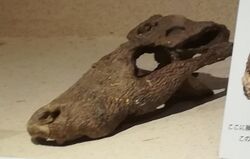Biology:Navajosuchus
| Navajosuchus | |
|---|---|

| |
| Navajosuchus sp. in National Museum of Nature and Science | |
| Scientific classification | |
| Domain: | Eukaryota |
| Kingdom: | Animalia |
| Phylum: | Chordata |
| Class: | Reptilia |
| Clade: | Archosauromorpha |
| Clade: | Archosauriformes |
| Order: | Crocodilia |
| Family: | Alligatoridae |
| Subfamily: | Alligatorinae |
| Genus: | †Navajosuchus Mook, 1942 |
| Type species | |
| †Navajosuchus mooki (Simpson, 1930 [originally Allognathosuchus mooki])
| |
Navajosuchus is an extinct genus of alligatorine crocodylian. Its fossils have been found in the Paleocene-age Nacimiento Formation of the San Juan Basin, New Mexico (United States ). It was named in 1942 by Charles C. Mook, and the original type species was N. novomexicanus. N. novomexicanus was based on AMNH 5186, a partial skull collected in 1913.[2] Later research showed that Navajosuchus novomexicanus was the same as the earlier-named Allognathosuchus mooki.[3] However, A. mooki does not belong to the genus Allognathosuchus, and so the name of the crocodilian becomes Navajosuchus mooki.[4] Under whichever name is used, this animal would have been a generalized predator of the Nacimiento floodplains. It was the most common Nacimiento Formation crocodilian, found in both the Puercan and Torrejonian faunal assemblages.[5]
The precise placement of Navajosuchus within Alligatoroidea is disputed. Some studies have shown it as a basal member of Alligatoridae, within the stem-based group Alligatorinae,[6][7] as shown in the cladogram below.[7]
| Alligatoroidea |
| |||||||||||||||||||||||||||||||||||||||||||||||||||||||||||||||||||||
| (stem‑based group) |
Alternatively, other studies have recovered Navajosuchus outside of Alligatoridae and Alligatorinae, as a basal member of Alligatoroidea within the clade Globidonta,[8][9] as shown in the cladogram below.[9]
| Alligatoroidea |
| |||||||||||||||||||||||||||||||||||||||||||||||||||||||||||||||||||||||||||
References
- ↑ Rio, Jonathan P.; Mannion, Philip D. (6 September 2021). "Phylogenetic analysis of a new morphological dataset elucidates the evolutionary history of Crocodylia and resolves the long-standing gharial problem". PeerJ 9: e12094. doi:10.7717/peerj.12094. PMID 34567843.
- ↑ Mook, Charles C. (1942). "A new fossil crocodilian from the Paleocene of New Mexico". American Museum Novitates (1189): 1–4. http://digitallibrary.amnh.org/dspace/bitstream/2246/2274/1/N1189.pdf.
- ↑ Sullivan, R.M.; Lucas, S.G.; Tsentas, C. (1988). "Navajosuchus is Allognathosuchus". Journal of Herpetology 22 (1): 121–125. doi:10.2307/1564367.
- ↑ Brochu, Christopher A. (2004). "Alligatorine phylogeny and the status of Allognathosuchus Mook, 1921". Journal of Vertebrate Paleontology 24 (4): 857–873. doi:10.1671/0272-4634(2004)024[0857:APATSO2.0.CO;2].
- ↑ Lucas, S.G. (1992). "Cretaceous-Eocene crocodilians from the San Juan Basin, New Mexico". in Lucas, S.G.. San Juan Basin IV. New Mexico Geological Society Guidebook. 43. Socorro, New Mexico: New Mexico Geological Society. pp. 257–264. ISBN 99922-2-673-0.
- ↑ Paula Bona; Martín D. Ezcurra; Francisco Barrios; María V. Fernandez Blanco (2018). "A new Palaeocene crocodylian from southern Argentina sheds light on the early history of caimanines". Proceedings of the Royal Society B: Biological Sciences 285 (1885): 20180843. doi:10.1098/rspb.2018.0843. PMID 30135152.
- ↑ 7.0 7.1 Adam P. Cossette; Christopher A. Brochu (2020). "A systematic review of the giant alligatoroid Deinosuchus from the Campanian of North America and its implications for the relationships at the root of Crocodylia". Journal of Vertebrate Paleontology 40 (1): e1767638. doi:10.1080/02724634.2020.1767638. Bibcode: 2020JVPal..40E7638C.
- ↑ Michael S. Y. Lee; Adam M. Yates (27 June 2018). "Tip-dating and homoplasy: reconciling the shallow molecular divergences of modern gharials with their long fossil". Proceedings of the Royal Society B 285 (1881). doi:10.1098/rspb.2018.1071. PMID 30051855.
- ↑ 9.0 9.1 Tobias Massonne; Davit Vasilyan; Márton Rabi; Madelaine Böhme (2019). "A new alligatoroid from the Eocene of Vietnam highlights an extinct Asian clade independent from extant Alligator sinensis". PeerJ 7: e7562. doi:10.7717/peerj.7562. PMID 31720094.
Wikidata ☰ Q16986229 entry
 |

